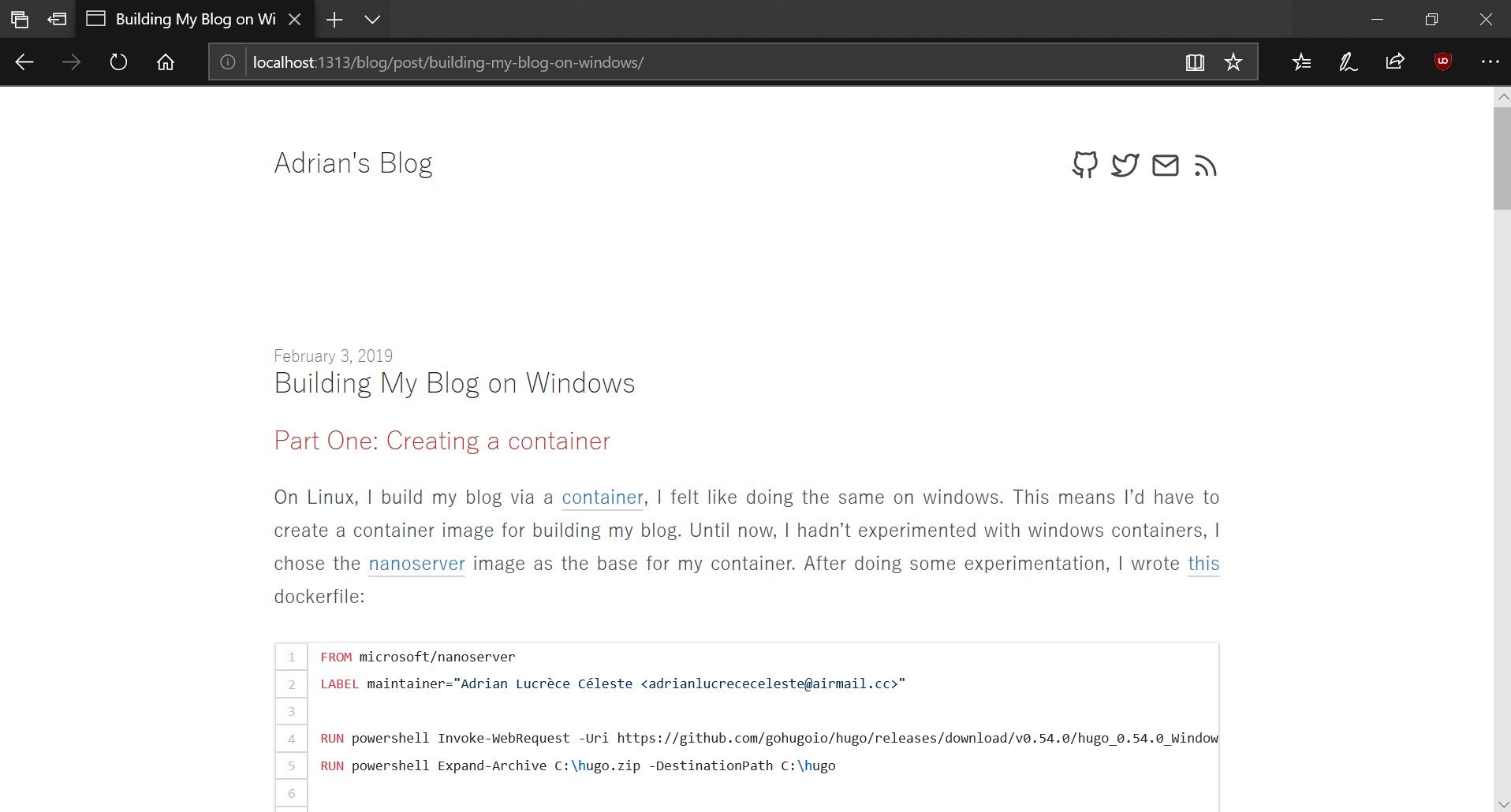Part One: Creating a container
On Linux, I build my blog via a container, I felt like doing the same on windows. This means I’d have to create a container image for building my blog. Until now, I hadn’t experimented with windows containers, I chose the nanoserver image as the base for my container. After doing some experimentation, I wrote this dockerfile:
FROM microsoft/nanoserver
LABEL maintainer="Adrian Lucrèce Céleste <[email protected]>"
RUN powershell Invoke-WebRequest -Uri https://github.com/gohugoio/hugo/releases/download/v0.54.0/hugo_0.54.0_Windows-64bit.zip -Outfile hugo.zip
RUN powershell Expand-Archive C:\\hugo.zip -DestinationPath C:\\hugo
WORKDIR C:\\workspace
CMD [ "--help" ]
ENTRYPOINT [ "C:\\hugo\\hugo.exe" ]
For those unfamiliar with docker, this file can be easily broken down line-by-line.
FROM microsoft/nanoserver
This line tells docker what image we want to base our container off of, in this case, I’m using microsoft’s nanoserver image.
LABEL maintainer="Adrian Lucrèce Céleste <[email protected]>"
This line tells docker who the maintainer of this image is, by applying a label.
RUN powershell Invoke-WebRequest -Uri https://verlonglink.com -Outfile hugo.zip
The RUN statement tells docker to run powershell with the specified parameters
inside the container, Invoke-WebRequest is how I download the .zip that hugo
comes packaged in for windows.
RUN powershell Expand-Archive C:\\hugo.zip -DestinationPath C:\\hugo
Here, powershell is unzipping the archive to C:\hugo for us.
WORKDIR C:\\workspace
WORKDIR tells the container what directory to start out in at runtime.
CMD [ "--help" ]
CMD provides a default argument for the container while running, the container
passes --help to our ENTRYPOINT of C:\hugo\hugo.exe.
ENTRYPOINT [ "C:\\hugo\\hugo.exe" ]
The last and final line, ENTRYPOINT which tells the container what executable
(and optionally, parameters) we want to use during runtime.
Preface
Part two is outdated, I now just use wsl to run hugo from instead of using
a windows docker container.
Part Two: Setting up VScode to use the container on windows
Before in my tasks.json,
I only had one command and one args section per task, now I seperate them
based on the OS that VScode is running on. So now if I wanted to preview my blog
on windows, all I have to do is run the Preview task, and the container will
be spun up, the ports mapped, and I can just open a web browser and look at my
progress. Building is also as easy as just running the build task.

{
"version": "2.0.0",
"tasks": [
{
"label": "Preview",
"type": "process",
"linux": {
"command": "podman",
"args": [
"run",
"--rm",
"--net=host",
"--name=hp",
"-v",
"${workspaceFolder}:/workspace:z",
"quay.io/adrianlucrececeleste/alpine-hugo:latest",
"serve",
"--theme=kiss",
"--source=/workspace/src",
"--buildDrafts"
]
},
"windows": {
"command": "docker",
"args": [
"run",
"--rm",
"-it",
"--isolation=hyperv",
"--name=hp",
"-p",
"1313:1313",
"-v",
"${workspaceFolder}:C:\\workspace",
"adrianlucrececeleste/windows-hugo:latest",
"serve",
"--theme=kiss",
"--bind",
"0.0.0.0",
"--source=src",
"--buildDrafts"
]
},
"problemMatcher": []
},
{
"label": "Build Blog",
"type": "process",
"linux": {"command": "podman",
"args": [
"run",
"--rm",
"--net=host",
"--name=hb-$(git rev-parse HEAD)",
"-v",
"${workspaceFolder}:/workspace:z",
"quay.io/adrianlucrececeleste/alpine-hugo:latest",
"--cleanDestinationDir",
"--source=/workspace/src",
"--destination=/workspace/docs",
"--theme=kiss",
]
},
"windows": {
"command": "docker",
"args": [
"run",
"--rm",
"--isolation=hyperv",
"-it",
"--name=hb",
"-p",
"1313:1313",
"-v",
"${workspaceFolder}:C:\\workspace",
"adrianlucrececeleste/windows-hugo:latest",
"--cleanDestinationDir",
"--source=C:\\workspace\\src",
"--destination=C:\\workspace\\docs",
"--theme=kiss"
]
},
"problemMatcher": [],
"group": {
"kind": "build",
"isDefault": true
}
}
]
}